Dental Caries
Master the INBDE with Dental Panda: Your go-to resource for expert practice exams and tailored study resources!
DENTAL PLAQUE
Plaque is a biofilm made up of microorganisms (95%) and organic components, like polysaccharides, proteins, and glycoproteins (5%), that sticks to just about anything in the oral environment. It can be classified as supragingival or subgingival. Plaque formations start with pellicle formation, salivary proteins binding to the surfaces of teeth. Bacteria colonize this protein blanket and the biofilm slowly matures from an early aerobic environment characterized by gram-positive species to an increasingly anaerobic environment characterized by gram-negative anaerobes. Subgingival plaque favors anaerobic bacteria. Plaque formation is a key etiological factor for caries and periodontal disease. When plaque matures and mineralizes it forms calculus. Though there is variation between individuals, 50% mineralization occurs in about 2 days, 90% in 12 days.
RISK FACTORS
The goal of examinations are to diagnose caries activity early, and if found treat so as to arrest and remineralize the damaged tooth structure. Only when irreversible damage occurs are restorations warranted. Whether to treat or not can largely depend on the caries risk of the individual, which is affected by their caries history, diet, use of fluoride, age, oral hygiene, existing restorations, bacterial profile, and salivary defects. Moderate risk factors can include:
- Recreational drug use.
- White spot lesions.
- Early interproximal enamel lesions.
- Exposed root surfaces (especially in elderly patients).
- Deep pit and fissures.
- Crowding.
- Inadequate fluoride exposure.
More care needs to be taken with higher risk factors, which could include:
- Poor oral hygiene.
- Visible cavitation, two or more active carious lesions.
- Visible plaque.
- Restorations within the last few years, or a large number or restorations.
- Frequent snacking.
- Inadequate quantity or quality of saliva.
- Medications known to cause xerostomia.
- Poor dexterity (special needs, young kids, elderly).
- appliance (orthodontic, removable partial dentures etc.).
The ADA’s information on caries risk can be found here. The presence of several facial (or lingual) smooth-surface carious lesions within a patient’s dentition indicate a high caries rate. The caries rate will largely dictate how often you take radiographs and which ones you take. Many medications can play a role in salivary function, which is one of the strongest etiological factors for high caries risk. These include
- Anticholinergics – Atropine, glycopyrolate, scoplomine.
- Diuretics – Hydrochlorothiazide.
- Local anesthetics – Lidocaine.
- Antipsychotics – Chlorpromazine.
- Beta-blockers – Atenolol.
- Benzodiazepines – Alprazolam.
- Antihistamines – Chlorpheniramine.
CARIOGENIC BACTERIA
For this infectious microbiological disease process to start 3 things are needed: cariogenic bacteria, a susceptible surface, and fermentable carbohydrates.
Cariogenic bacteria produce sticky sugar polymers (polysaccharides) from dietary sugars (turns sucrose into fructans and glucans) via glucosyltransferase which allows the bacteria to adhere to the tooth surfaces. A relatively small proportion of bacteria in the mouth are cariogenic. They are acidogenic (produce acid) and aciduric (tolerate acidic environments). Lactic acid is formed when sucrose is metabolized, lowering the surrounding pH and ultimately leading to surface demineralization. These bacteria can also produce bacteriocins to kill competing organisms.
The Stephan curve depicts a rapid drop in oral pH after a meal or drink containing fermentable carbohydrates. The critical pH for enamel is 5.5, below which breakdown occurs. The critical pH for dentin is around 6.5. Recovery takes around 15-40 minutes. The frequency of available fermentable carbohydrates has more of an impact than quantity because it holds the curve below 5.5 longer. Saliva functions to buffer the fall in pH and provides the teeth with the mineral components (Ca, phosphate, F) to remineralize and strengthen tooth structure.
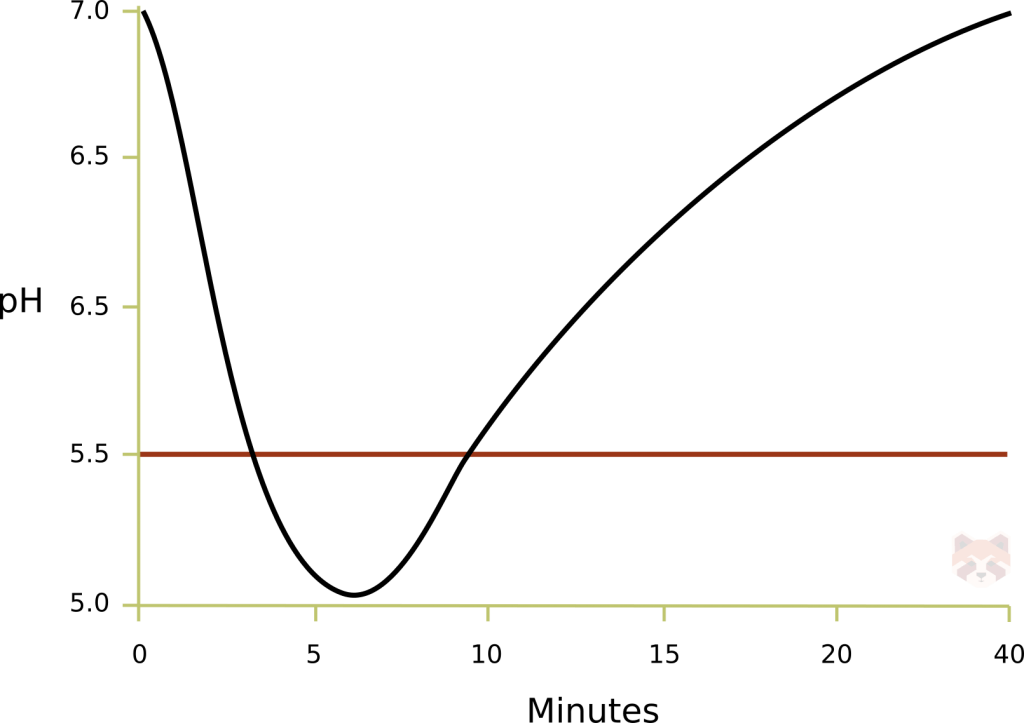
Streptococcus mutans and Lactobacilli are the primary species associated with caries. The three cariogenic bacterial families you should link to dental decay are:
- Streptococcus species (S. mutans, S. sanguis, S. salivarius, S. mitis) generally cause pit and fissure, smooth-surface, and root caries.
- Lactobacillus species (L. casei, L. acidophilus, L. veillonella) generally cause pit and fissure caries.
- Actinomyces species (A. viscosus, A. naeslundii) generally cause root caries.
It takes around 24 hours for the bacterial biofilm to mature and cause a localized drop in pH. It may take one to two years before there is enough demineralization to cause the loss of enamel surface integrity. Once the bacteria reach dentin the tubular structure and lower mineralized content allows for faster progression. A layer of infected dentin contains bacteria within the tubular structure and would need to be removed in order to restore the tooth. The underlying layer of affected dentin might still contain bacteria but a much smaller amount. Demineralization has occurred but may be reversible in a favorable environment. If you risk pulpal compromise by removing this affected layer, some operators would suggest leaving it and including an indirect pulp capping step into the restorative procedure.
Incipient caries refers to “minor” destruction that has not moved further than the enamel layer. The area is able to remineralize and stabilize. If there is no loss in surface integrity, remineralization and regular monitoring is the first line treatment. Remineralization is only possible if there is no cavitation. Once the lesion extends beyond the DEJ it needs to be restored.
Arrested caries describes an area damaged by demineralization, but underwent remineralization. The discolored areas exist because of staining incorporated into the tooth structure after demineralization. Though the surface color indicates caries (dark brown or black), the surface is usually hard. Despite the possibility of having a radiographic appearance of caries these lesions do not require treatment, only to monitor.
Frank caries describe caries that has moved beyond the dentinoenamel junction (DEJ).
Recurrent caries, also known as secondary caries, is decay that makes its way back in between a restoration and the tooth after it is restored.
Rampant caries refers to rapidly progressing wide spread carious lesions. Usually there is a clear contributing factor (poor oral hygiene, drug abuse, radiation, high sugar diets, xerostomia, etc.).
Pit and fissure enamel is the most likely area to find caries, and though the enamel portion can be narrow, it usually balloons out into a V shape once it progresses past the DEJ. Damage can be prevented with pit and fissure sealants.
Smooth surface caries, the second most susceptible area, generally start interproximally just gingival to the proximal contact. Caries starts wide as it moves to the DEJ in a V shape. Fluoride is of greatest benefit to smooth surfaces but not as beneficial for pit and fissure caries.
Root surface caries is linked to older patients exhibiting more clinical recession and subsequent root surface exposure. The cementum surface is rougher, thin and less mineralized compared to enamel so plaque adheres to and damages it more readily. Age is also associated with decreased salivary flow (most often due to polypharmacy-induced xerostomia) and inability to clean the teeth well. Recall the zones of carious enamel and dentin:
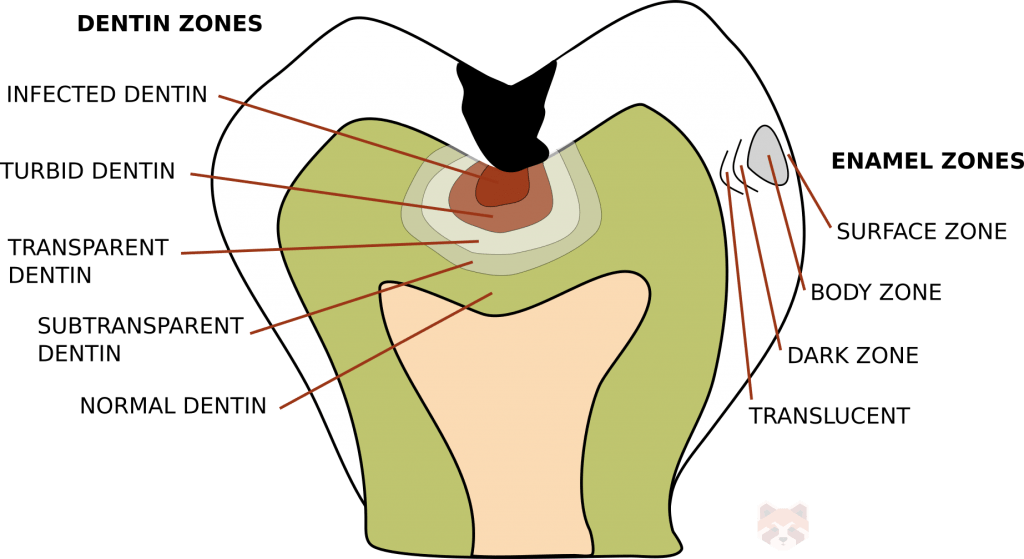
Enamel
- Translucent zone – faint appearance under polarized light. The advancing front of caries.
- Dark zone – inability to transmit polarized light. Mixed demineralization and remineralization.
- Body zone – the largest zone and the area with the most demineralization.
- Surface zone – seems relatively unaffected.
Dentin
- Normal dentin – no bacteria or byproducts present.
- Subtransparent dentin – demineralization but no bacteria found in dentinal tubules. Affected dentin.
- Transparent dentin – further demineralization, still no/very little bacteria. Affected dentine.
- Turbid dentin – bacteria present in the dentin tubules. Infected dentin. Must remove this zone.
- Infected dentin – many bacteria found in this zone. Infected dentin. Must remove this zone.
PIT AND FISSURE CARIES
Pit and fissure lesions are easily recognizable when cavitated but can be difficult to locate in the early stages. Often there is staining in the pit and fissure system (though this alone is not definitive). Beyond the deeply discolored fissure a “halo” may be evident. An opaque/white halo could indicate demineralized enamel. A dark halo could signify carious progression into the underlying dentin while the enamel remains mainly intact.
Probing pits and fissures can be a controversial subject. Some find the tactile feedback (sticky, retentive pit or fissure) from the probe useful. But studies have shown that a sticky feeling with a sharp explorer may not be the best identifier of active caries, and could itself irreversibly damage tooth structure that may have responded to remineralization techniques. Pit and fissure caries do not appear so readily and clearly on radiographs when compared to interproximal caries.
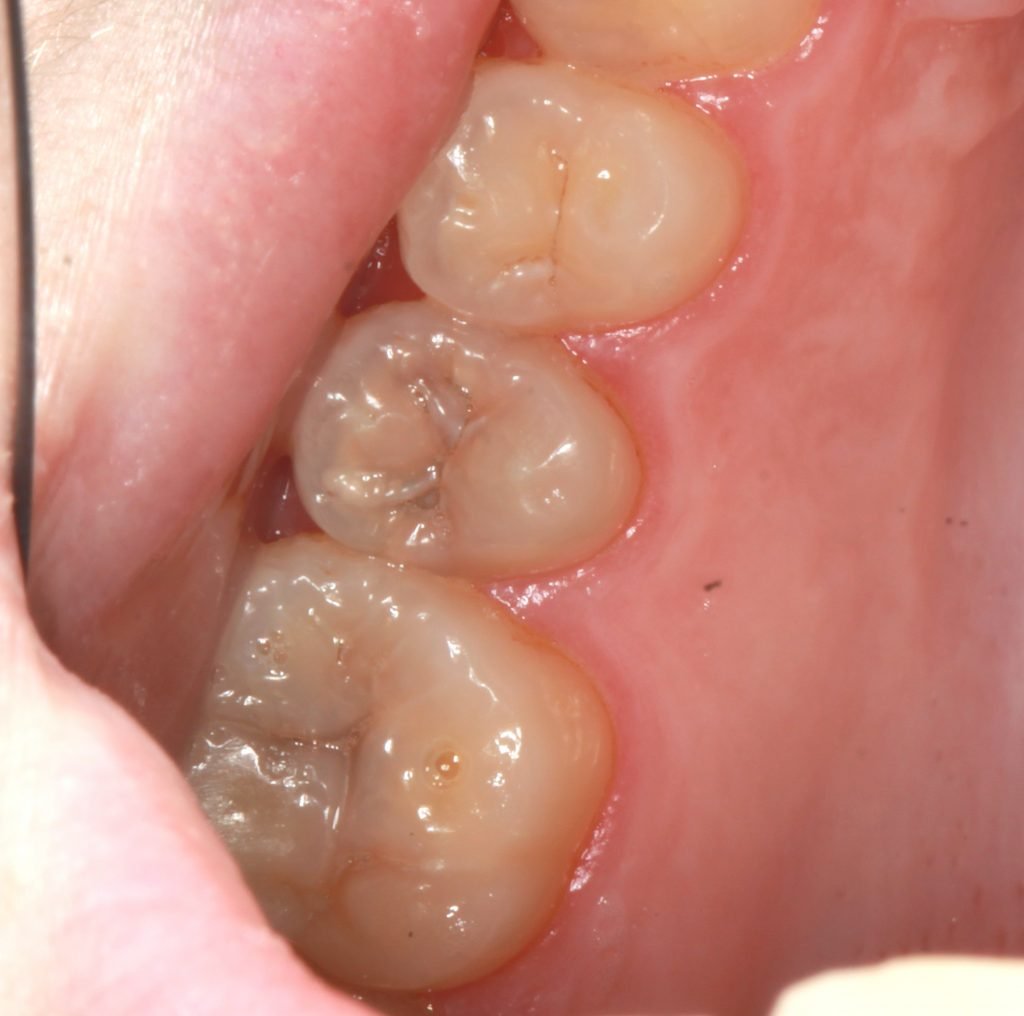
Note the shadowing around the fissure system of the second premolar and first molar, compared to the first premolar.
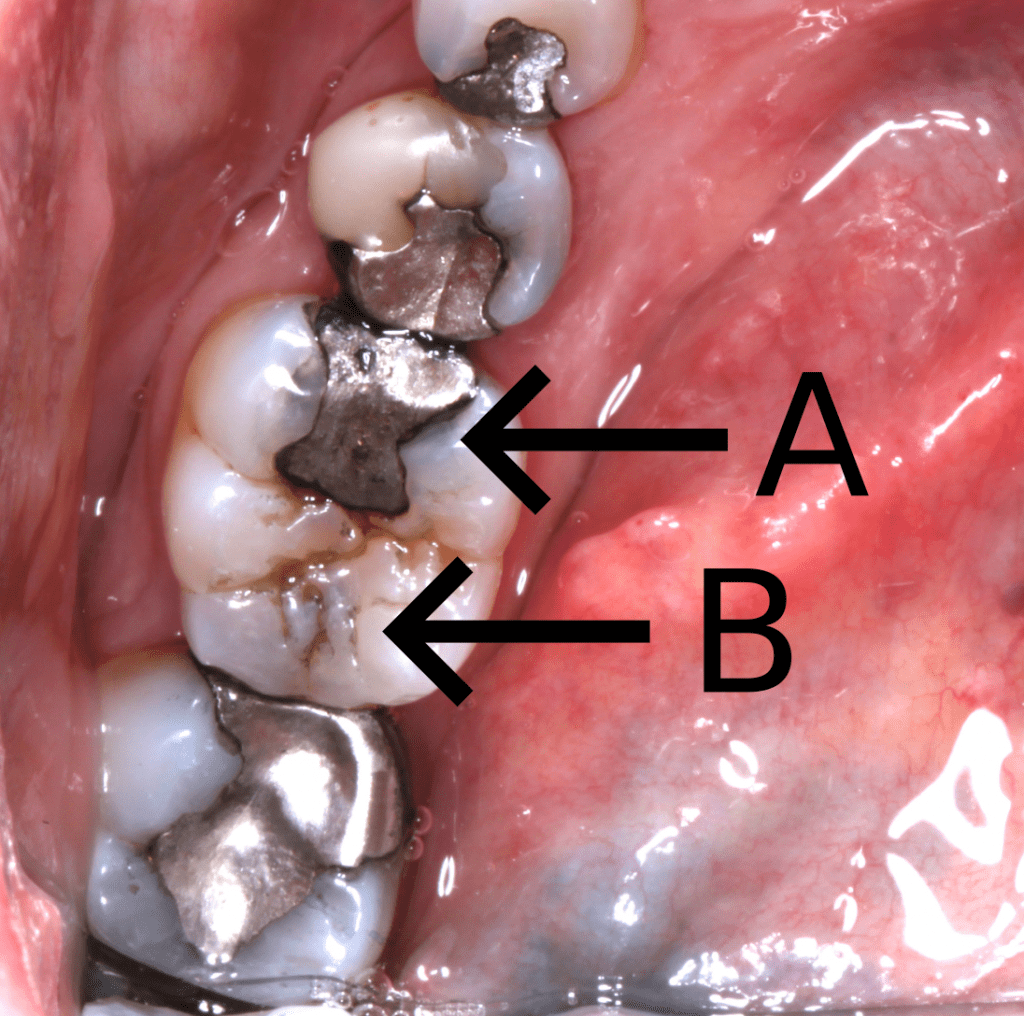
A. Shadowing caused by corrosion byproducts
B. Shadowing caused by caries
SMOOTH SURFACE CARIES
For the most part smooth surface interproximal caries is picked up during routing radiographs. 30% or more of the mineral structure needs to be lost before a carious lesion is distinguishable on a radiograph. A radio-opacity just below the interproximal contact suggests caries. Once found it can be difficult to accurately assess whether a lesion is active or inactive. Lesions may be active if the patient has an overall high caries risk, the lesion was not present at a previous exam, or the caries extends into the dentin. Lesions may be inactive if successive bitewing radiographs show no lesion progression, or the patient has a low caries risk.
As the active carious lesions grow, shadowing may be evident when viewed from the occlusal, and ultimately the undermined marginal ridge will break down. Early smooth surface lesions on the labial and lingual surfaces of the teeth start as a white spot with a frosted appearance. Wetting the tooth sees it disappear, drying the tooth makes the spot return. This is helpful because inherent defects like hypocalcification will not disappear like this. The best way to diagnose distal caries on a canine is with a bite-wing radiograph.
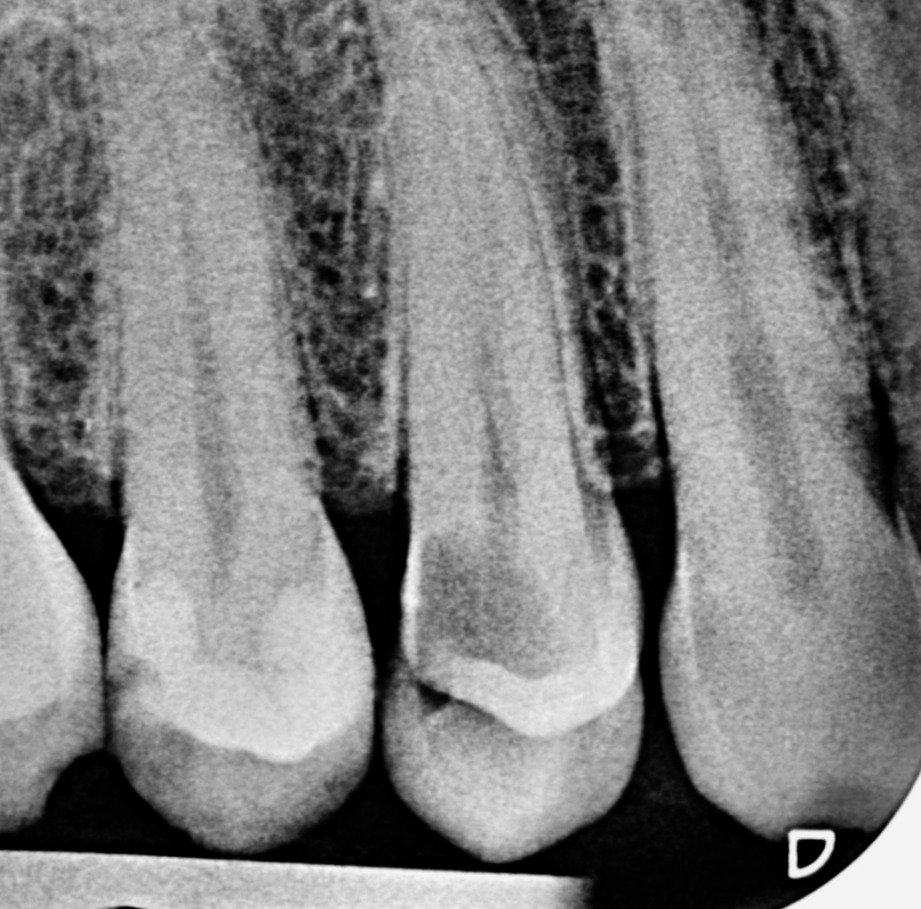
Large distal carious lesion on the upper right first premolar.
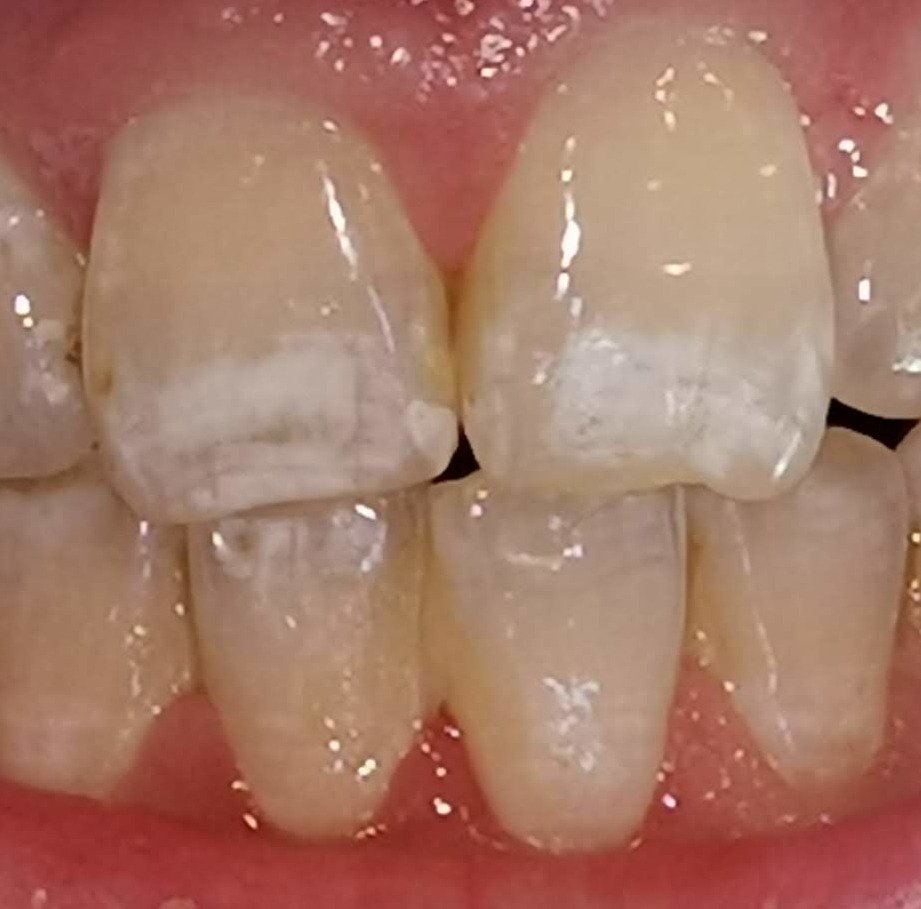
Wetting & drying these hypomineralized enamel lesion will not make them disappear.
ROOT SURFACE CARIES
Generally root surface lesions are the easiest to diagnose, but not always. Gingival hypertrophy may hide caries on the previously exposed root surfaces. Interproximal root surface lesions on teeth with vertical loss of attachment require careful probing or supplemental radiographs. Though care needs to be taken not to mistake the normal radiolucent appearance just below the CEJ area (cervical burnout) with dental decay. The surface is discolored, often visibly damaged, and soft or sticky to an explorer. These lesions tend to spread laterally following the CEJ/gingival margin. If the surface is discolored but hard to the explorer, it may be a sign of arrested (inactive) caries. The lesion presents with eburnated dentin (sclerotic dentin).
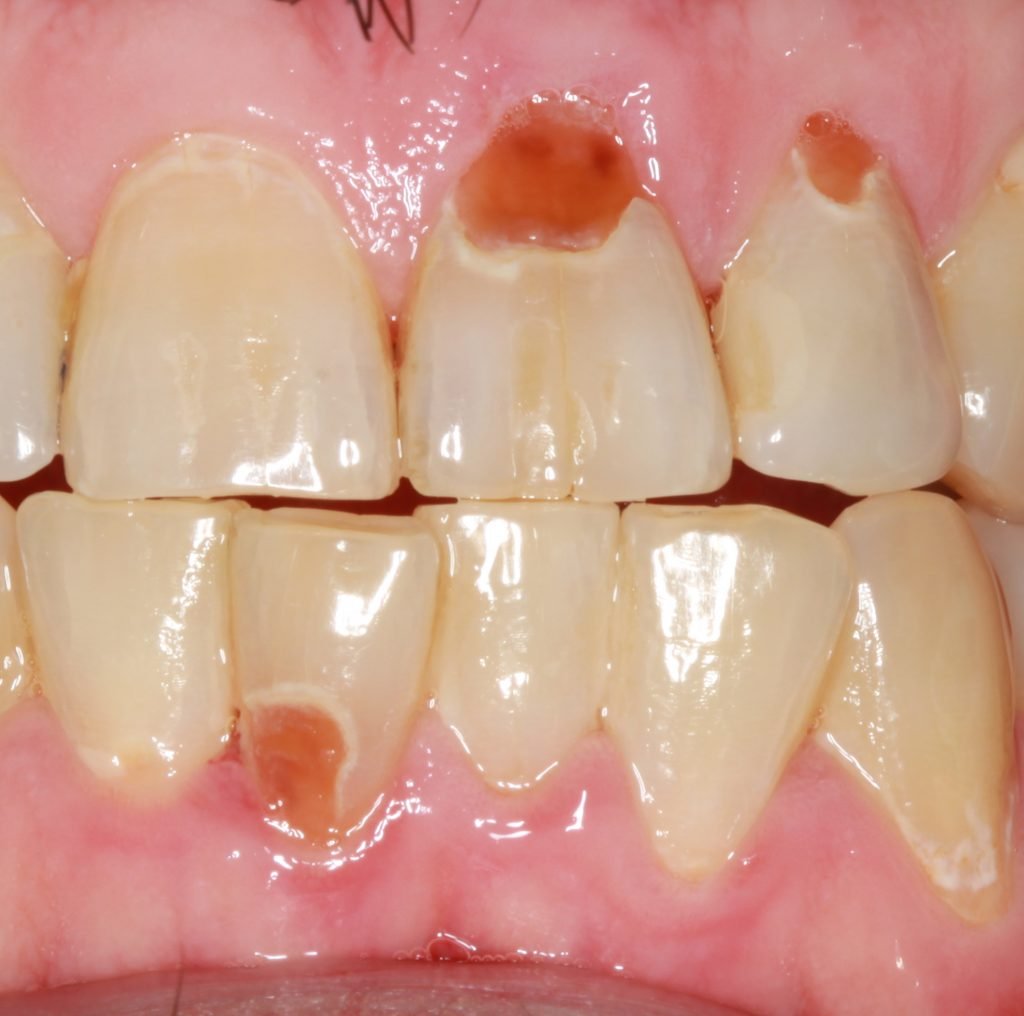
Note the white “halo” of demineralized enamel 1) around the periphery of these carious lesions, and 2) following the gingival margin of the upper right central incisor and lower left canine.
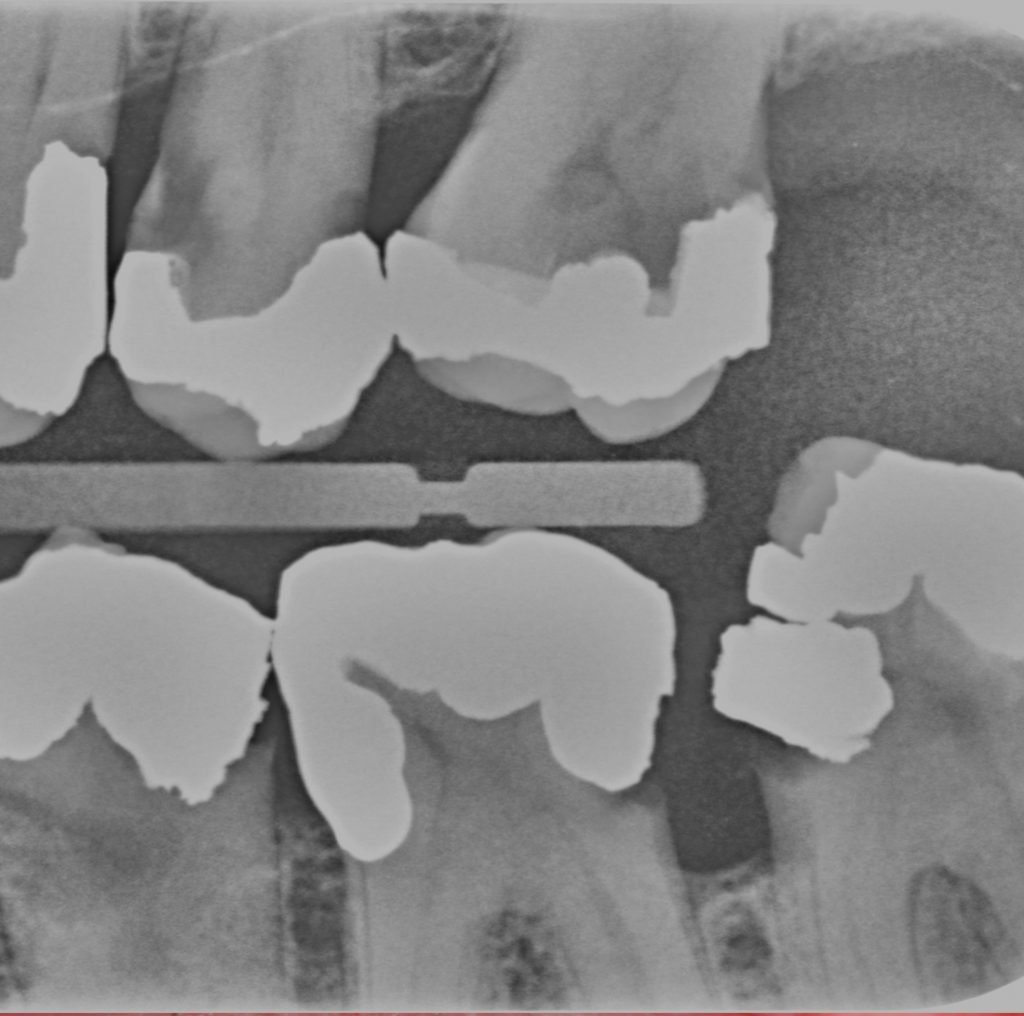
Multiple extensive root surface lesions. These can be classified as secondary caries.

The patient lost a Class V restoration on their lower right first premolar. The arrested carious lesion presented with hard, sclerotic dentin (erburnated dentin).
TRANSILLUMINATION
Shining a light through a tooth can be a valuable tool to detect caries and cracks in teeth. Carious enamel and dentin blocks light causing shadowing. Cracks will interrupt the light passing through
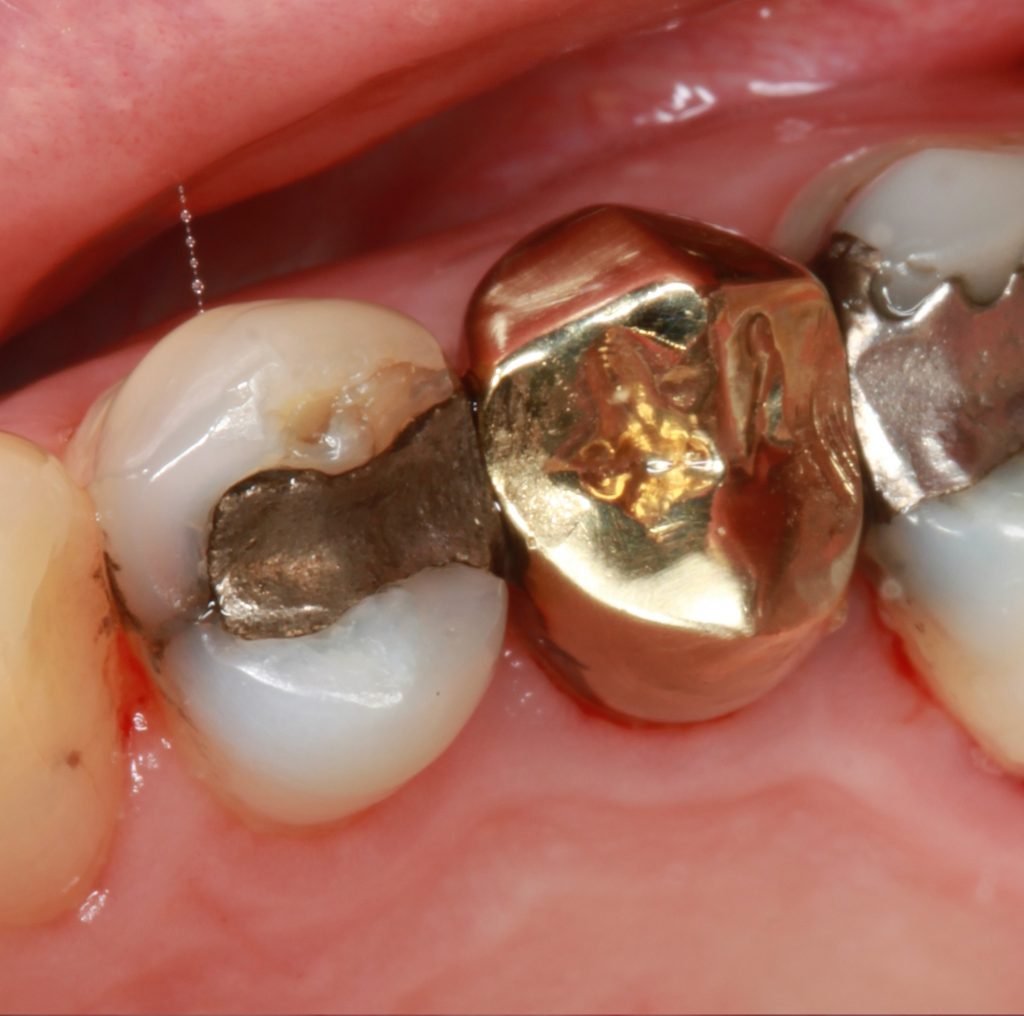
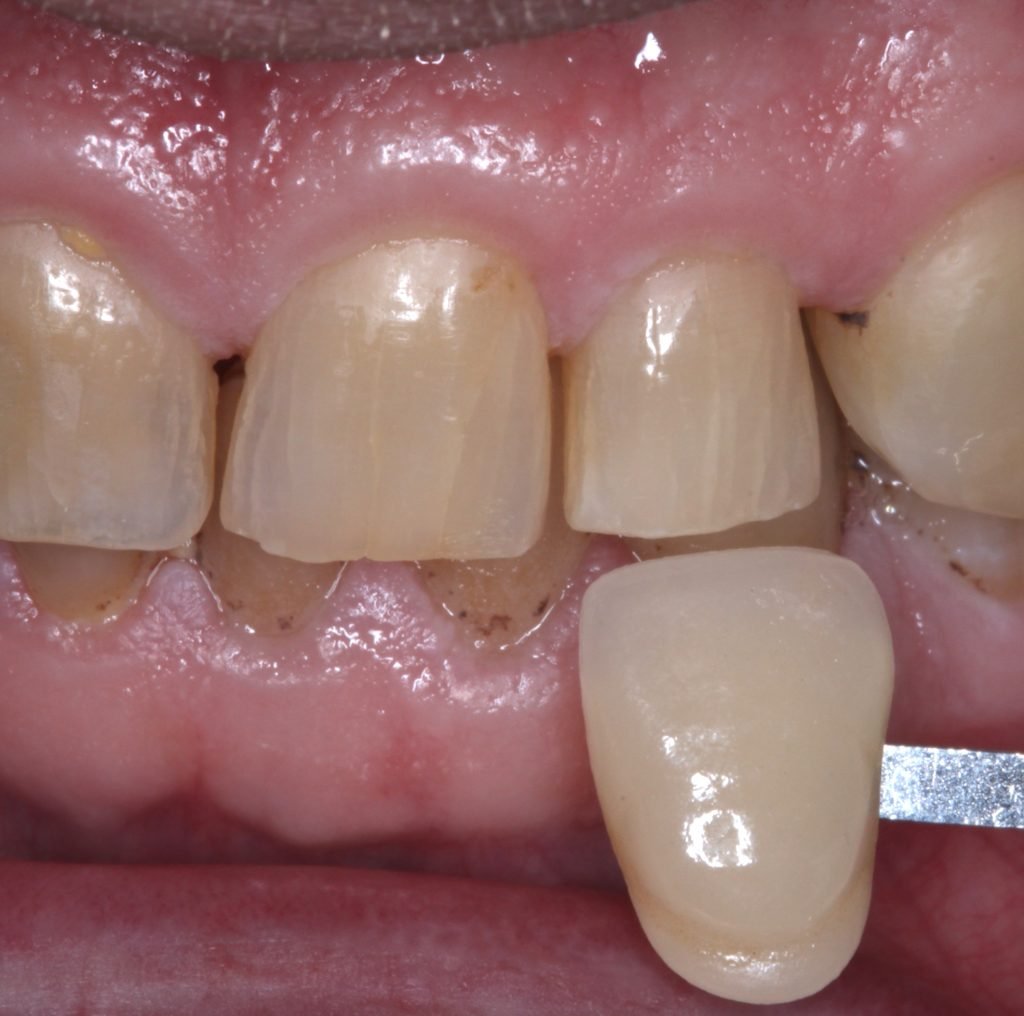
ADDITIONAL TOOLS
Caries detector solutions are materials typically composed of a colored (red) food dye and propylene glycol base. It stains the outer carious dentin bright red but does not stain the inner affected layer or normal dentin. Caries detector solution helps with the differentiation and removal of infected dentin. These dyes are not specific for detecting infected dentin, they only stain the organic matrix of less mineralized dentin. Be aware of false positives and use them with caution, particularly in deep cavity preparations, to avoid pulp exposure.
Examples of detection technologies are laser fluorescence (DIAGNOdent), transillumination (Electro-Optical Sciences) or a combination of noncontacting modulated laser luminescence and photothermal radiometry.
FAILED RESTORATIONS
Some localized defects can be conservatively repaired, though if the following is found it could warrant replacement:
- Marginal void, especially in the gingival third.
- Marginal staining deemed leading to marginal leakage.
- Poor proximal contour or gingival overhang.
- A marginal ridge defect causing food impaction.
- Overcontour of a facial or lingual surface.
- Open proximal contact.
- Recurrent caries.
- Deep ditching.
Risk of caries or fracture, negative impact on the neighboring teeth, or poor esthetics could also see a restoration replaced. A patient in a high risk category may receive the following:
- Three-monthly recalls.
- Fluoride varnish at each visit.
- Dietary counseling and oral hygiene instruction.
- Bite-wing radiography at 6– 12 monthly intervals.
- Home fluoride rinses and dentifrices.
- Calcium phosphate products (e.g. GC Tooth Mousse).
- Use of sugar substitutes, e.g., xylitol.
- Saliva stimulants if saliva function is inadequate.
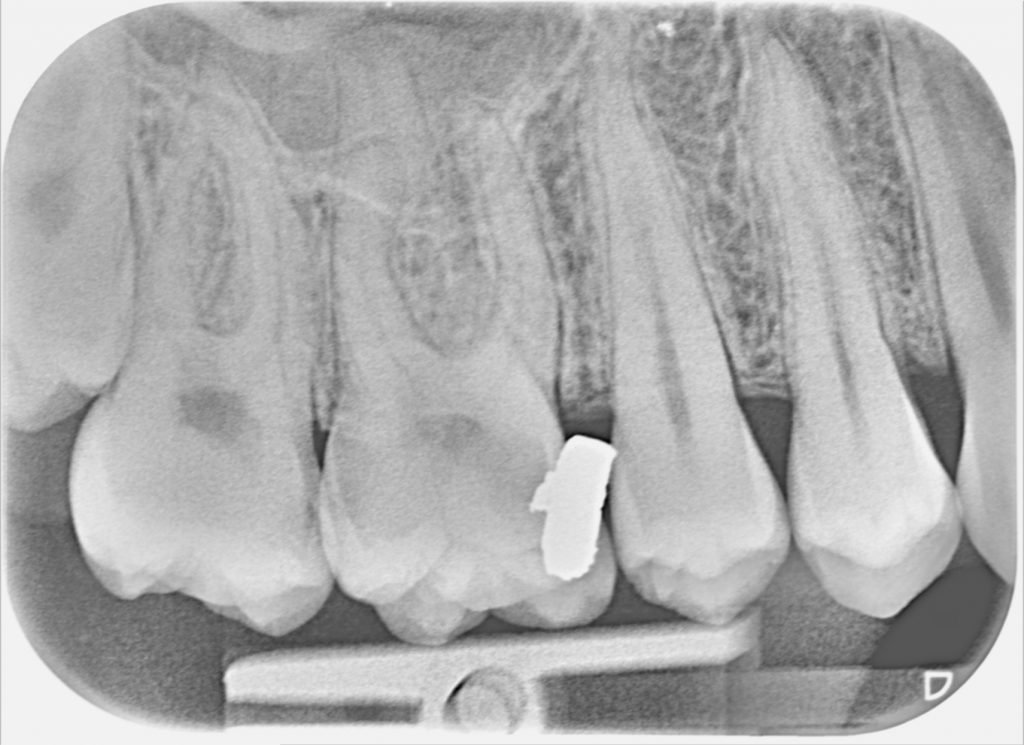
SECONDARY CARIES
Restoring a tooth does not eliminate the carious process if the oral environment is left unchanged. Poor oral hygiene, defective restoration margins, open contacts, overhangs, inferior dental materials, and fractured fillings can all lead to decay. Secondary caries is mainly seen at the interface of the filling and tooth. Hydrolysis of the resin bond used in composite leads to marginal leakage which is visible as marginal staining. Continued breakdown and bacterial ingress lead to caries in this area. Marginal staining is a sign of restorative failure.
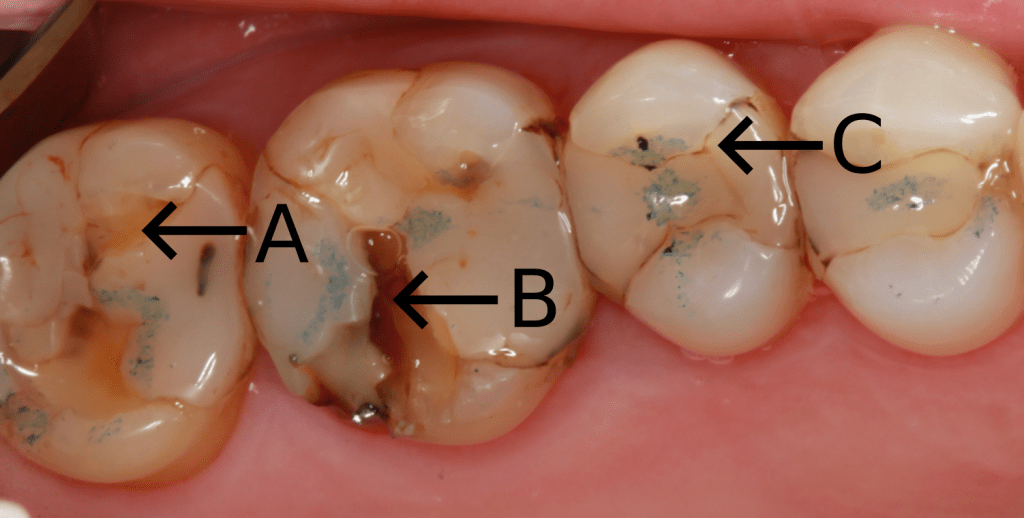
A. Sclerotic dentine, arrested caries
B. Secondary caries
C. Marginal leakage
